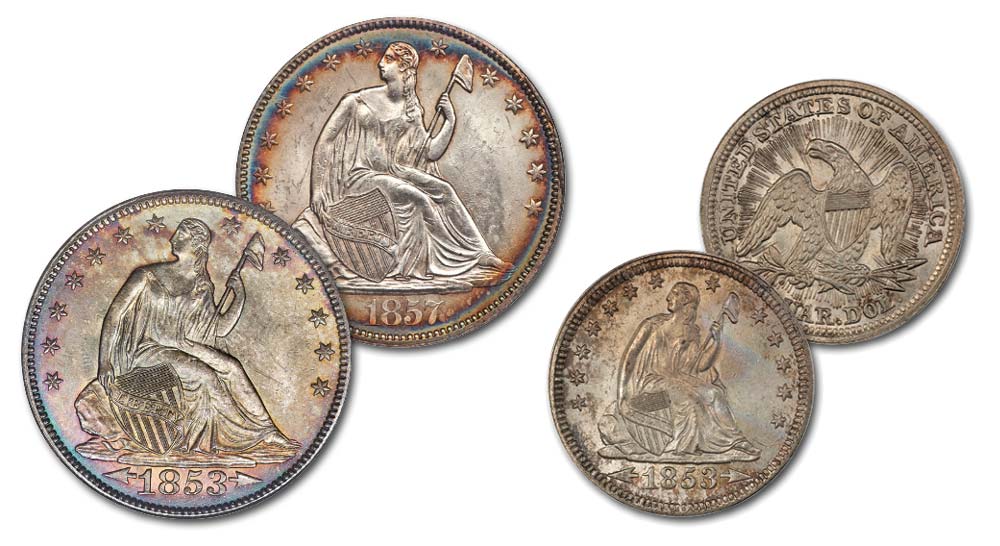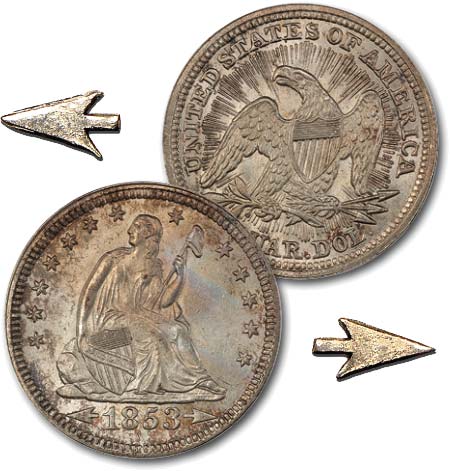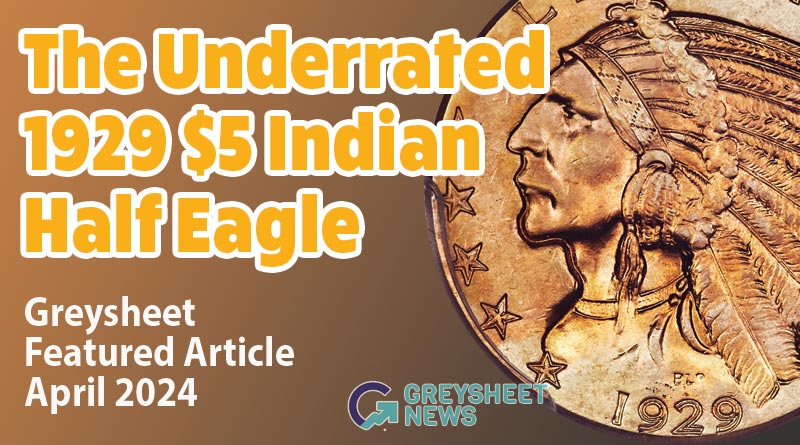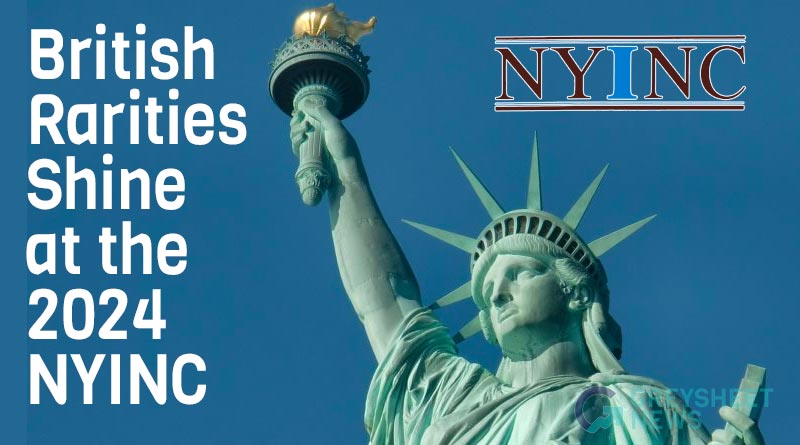Why Were Arrows Removed From Silver Coins by 1856?
The Coinage Act of 1853 added a new design feature to Liberty Seated coinage, but the ornaments would be short lived.
WITH THE IMPLEMENTATION of the Coinage Act of 1853, arrows were added to the designs of half dimes, dimes, quarters and half dollars. The arrows served as an announcement that the required silver content in new Liberty Seated silver coins had been reduced. The purpose of the announcement was to encourage people to spend new silver coins rather than saving, hoarding, melting or trading them. Why, though, were such arrows removed by 1856?
From 1856 until 1873, the silver content of silver coins continued to be in line with the Coinage Act of 1853. A law in 1873 led to the restoration of arrows on dimes, quarters and half dollars for reasons that are different from the reason that arrows were added to Liberty Seated coins, except silver dollars, in 1853.

An 1853 half dollar with arrows obverse (left); an 1857 half dollar obverse; and 1853 quarter dollar with arrows obverse and rays reverse.
Should arrows have continued in place after 1855 to indicate that post-1853 silver coins were specified to contain less silver than pre-1853 Liberty Seated silver coins of the same respective denominations and design types? The reason for the reduction in silver content relates to the value ratio of silver to gold.
The Coinage Act of 1792 established an official government ratio of silver to gold of 15:1. There was an official U.S. government policy of bimetallism, meaning both gold and silver were underpinnings of the monetary system. The U.S. dollar was based on the Eight Reales silver coin (Spanish Milled Dollar) of the Spanish Empire. Even so, one U.S. Dollar was defined as a weight in silver and separately as a weight in gold, with the idea that U.S. silver coins and U.S. gold coins would be interchangeable and that deposits of silver or gold could be freely exchanged at the mint for coins. The U.S. Mint then accepted deposits in silver and gold and minted coins for the depositors.
While the official government ratio stayed the same, the market ratio of the value of silver to the value of gold fluctuated. By the early 1830s, it became financially worthwhile for speculators in the U.S. to sell U.S. gold coins to traders in Europe for amounts greater than the face values of the respective coins. In the early 1830s, U.S. gold coins almost entirely disappeared from circulation in the U.S.
The official government ratio of silver to gold was changed by law in 1834 from 15:1 to 16:1. In other words, the value of one Troy ounce of gold was increased to sixteen Troy ounces of silver. Gold was legislated to be worth more than it was before, and the gold content of each new U.S. gold coin was thus reduced so gold coins would be spent rather than melted or exported. This change in ratio was an adjustment to market realities.
In the early 1850s, an opposite scenario manifested itself. The free market exchange rate of silver to gold dropped below 16:1. The value of one unit of weight of silver increased to the point that it was significantly above one-sixteenth (0.0625) of one unit of weight of gold. The value of gold decreased because massive quantities of gold were discovered in California in 1849.
In the early 1850s, the value of silver as bullion rose to the point that silver coins were worth more in bullion terms than their respective face values. For example, the silver in ten half dollars was worth more than one half eagle (U.S. $5 gold coin). By the early 1850s, there was a massive shortage of silver coins in circulation; very few people spent them in the United States.
The main purpose of the Coinage Act of 1853 was to reduce the silver content of new half dimes, dimes, quarters, and half dollars. The presence of arrows indicated that each contained less silver than coins of the same corresponding denominations did before 1853.
Yes, it is true that rays were added to the reverse designs of quarters and half dollars for one year only. Although the reasons why rays were dropped after 1853 are unknown in the present, it is likely that the adding of rays negatively affected the minting process of quarters and half dollars. The reverses became too heavily occupied by design elements without enough field space.
Just two arrows were added to each obverse design, and they did not require nearly as much space as rays. Would someone spending an 1856 or 1857 half dime, dime, quarter or half dollar, have wished to be informed via the presence of arrows that it contained less silver than a pre-1853 coin of the exact same respective design type?
For example, Liberty Seated With Stars, No Arrows half dimes that were minted before 1853 and after 1855 appear the same. Those minted from 1856 to 1859, however, contain less silver than half dimes of this design type minted before 1853.
Similarly, Liberty Seated No Motto, No Arrows half dollars were minted from 1839 until some point early in 1853 and then again from 1856 to 1866. Those No Motto half dollars minted from 1856 to 1866 each contain less silver than the earlier halves of the exact same design type.
Many people in 1856 must have been concerned about the long-term acceptability of post-1853, reduced silver content coins. The new silver coins with reduced silver content were legal tender only for amounts up to $5. Moreover, the U.S. Mint was not legally obligated to later accept at face value or to pay gold for these new silver coins. If arrows had remained after 1855, such arrows would have identified the coins in question as having reduced silver content, not in accordance with the 16:1 silver to gold standard.
Ever since I was a kid, I wondered why arrows were removed from the designs by 1856? Now, I theorize that the removal of arrows was intended to influence the behavior of consumers and merchants.
Don Taxay emphasizes in his epic book, The U.S. Mint & Coinage (NY: Arco, 1966, p. 224), that the law required that the mint disburse the newly minted, underweight silver coins at face value for deposits in gold, not in silver, so the quantities of underweight silver coins released would be just enough to meet the needs of circulation. U.S. Mint Director Eckert, however, violated or at least evaded the law by allowing for the reduced silver content coins to be paid out in exchange for deposits of silver, deposits which were used to mint still more reduced silver content (underweight) coins.
In June 1853, James Ross Snowden became the director of the mint. Snowden continued with policies that included paying out underweight silver coins at face value for silver bullion and then using the bullion at the Philadelphia Mint to produce more underweight silver coins. Leading historian R. W. Julian, in response to my inquiries, explains that Snowden “ignored the law, but only at the Philadelphia Mint, not in regard to the branch mint in San Francisco.”
By the middle of 1855, there were far too many underweight silver coins in circulation in Philadelphia and in some other cities on the Atlantic Coast. In his landmark reference, Fractional Money (NY: Wiley, 1930, p. 133), Neil Carothers reports that store owners discouraged customers from paying for goods with silver coins. Carothers adds that many banks “declined to accept deposits in silver coins” during 1854 and 1855.
Don Taxay emphasizes that the underweight silver coins minted in 1853 and 1854 “could neither be redeemed at the mint nor paid to the government in taxes. By 1855, they clogged the channels of trade, and the Mint itself acquired a large surplus” (Taxay, 1966, p. 226).
I theorize that Snowden had the arrows removed from designs, without explanation, while knowing this would cause uncertainty and cause many consumers to become anxious about the usefulness of some coins. Indeed, I maintain that Snowden wished to stop encouraging and to start discouraging the use of the underweight (reduced silver content) coins that stemmed from the Coinage Act of 1853. Have I solved the mystery of the removal of arrows by 1856?
Copyright ©2023 Greg Reynolds
Insightful10@gmail.com
Images courtesy of Heritage Auctions, HA.com

Download the Greysheet app for access to pricing, news, events and your subscriptions.
Subscribe Now.

Subscribe to Monthly Greysheet for the industry's most respected pricing and to read more articles just like this.
Source: Greg Reynolds











